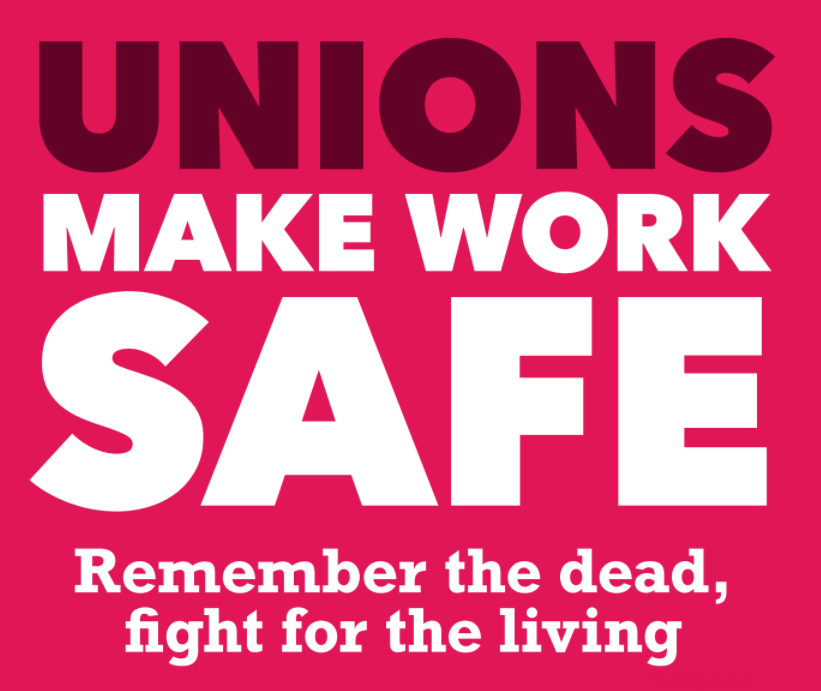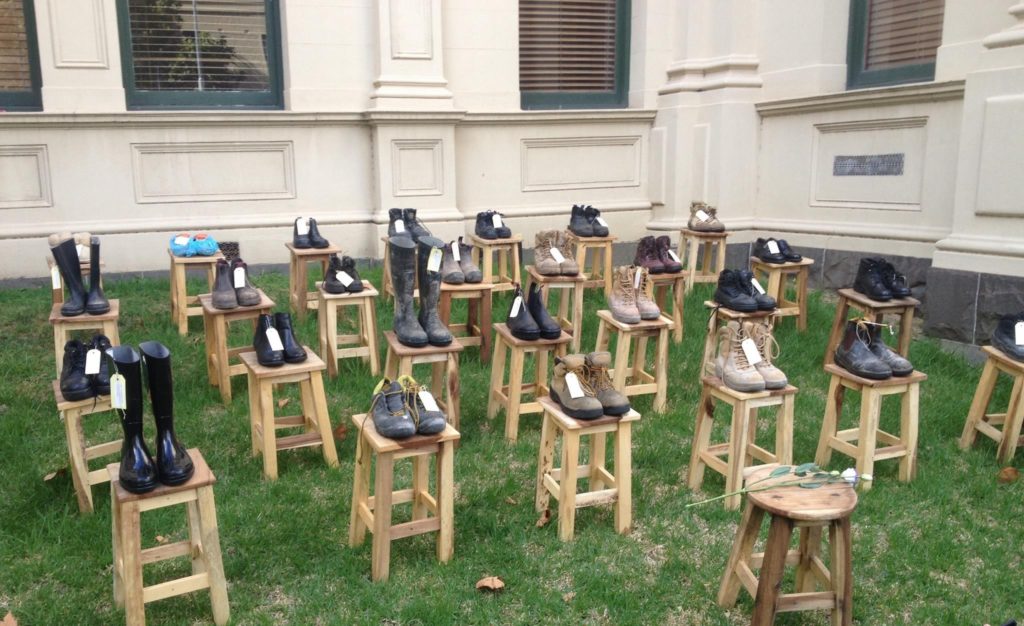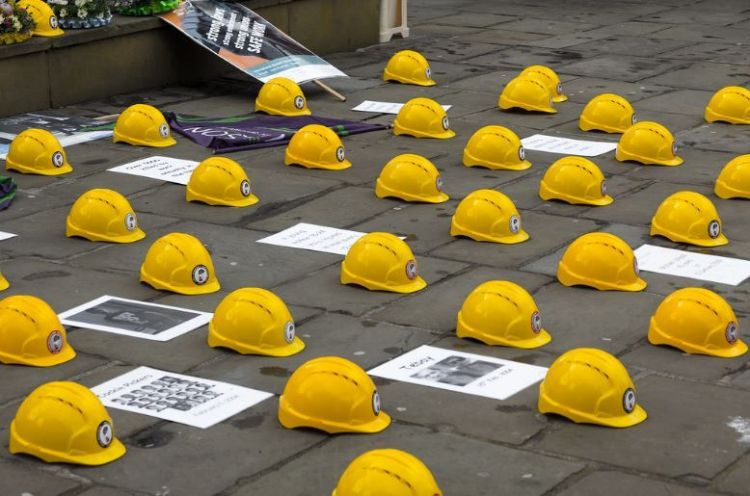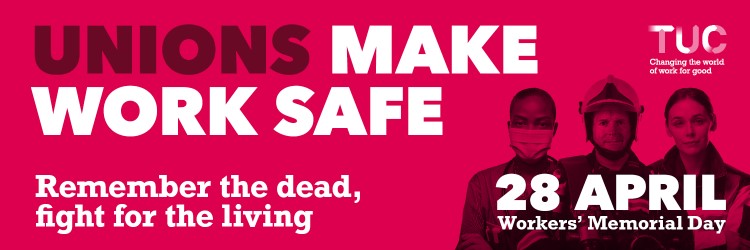By John Bryan – Camberwell and Peckham CLP – retired ex-building worker and blacklisted trade unionist.
International Workers’ Memorial Day (April 28th) was started in the USA by their trade union federation (AFL-CIO) in 1989 and has since become observed in many countries around the world. Its aim is to commemorate those who have been killed or injured at work. In the UK in 2019-20 111 workers died in workplace incidents, 86 of them in four sectors – Construction (40) Agriculture, Forestry and Fishing (20) Manufacturing (15) and Transport (11). Over the past year, the mortality from Covid 19 of both male and female workers in insecure jobs is twice that in other occupations. 14,500 of working age have died of Covid.
For more details and a list of events from the TUC you can click here.
In this article John Bryan, shares his personal recollections of battles over safety at work and victimisation.
On Workers Memorial Day, we especially remember those who lost their lives at work as we attend events up and down the country and world-wide, either in ‘real life’ or on the internet. I always bring to mind those workers physically and emotionally damaged by their work conditions, by inadequate health and safety and by the stress of blacklisting as well.
All through this pandemic, of course, construction sites in London have remained open and working. Building workers have gone into work throughout this period, nearly all using public transport, putting themselves, their families and other travellers at risk. You cannot construct buildings by working from home, or in isolation: construction is a physical and team effort. This has resulted in high infection rates and there have been over two thousand COVID related deaths! Of course, the directors of the companies live in their multi-million-pound houses in splendid isolation. Building workers’ lives have always been cheap.
During the past year there have been hundred of tower cranes, 23 in just the area where I live, in South East London. There are construction sites all over London – and more major projects are planned. How is this happening? It used to be said that the construction industry is the barometer of our economy, but with Brexit and the pandemic, how can this be so? With a London Labour Mayor friendly to big business, multinational developers and GLA Opportunity Areas in working class areas like the Old Kent Road, who are the opportunities for? Not the local communities whose needs are being overridden for the sake of the greed of multinational development companies, the social engineering ideals of planners and councillors of all political parties.

‘Health and Safety’ in the 1970’s
When I started working in construction in the mid 1970’s, you always knew who the foreman and charge hands were – they were the ones with hard hats! Changing rooms were a wooden shed with a bench with six-inch nails knocked into the wall to hang your jacket and personal stuff on. You had to hide your tools as best you could, as there were hardly any lockups. Toilet facilities were large buckets on each floor or out on the scaffold. A labourer got 50p a day extra ‘dirty’ money to clean the buckets every day and disinfect them. The only women on site were employed as secretaries. They had their own portaloos. You had to ask at the stores for safety gloves and a hard hat, which the storemen (company men) were always reluctant to give you. They acted as if the equipment was theirs, but any money they could save would be shared in the site management’s Christmas bonus.
At this time, on average six building workers were killed per month on site whilst at work, let alone the high level of injuries, many life-changing. The canteens were usually run by the partners or families of the site foremen – if you weren’t hit on the head by a falling brick or a piece of wood, they got you with norovirus! If you raised any of these issues with the trades’ foreman, they would come out with the old macho nonsense of “we are building workers, not office workers”. Even factory conditions were better.
Then there were the different ways of working, I always tried to work directly for the company but there were other forms of working, like the bogus self-employed ‘lump’, 715 tax receipt forms. Others were sub-contractors that would stop thirty percent of your wages to pay your tax and National Insurance but you were never sure if they would pay it, especially if you were on site for a few months at a time.
“We shouldn’t have to work like this!”
You could be ‘working direct’ for the main contractor at one end of the site and at the other end, another gang would be doing similar work but be on the ‘lump’. The foreman would often try to stir it up between the gangs for fun and divide and rule. Sometimes I had to work on the ‘lump’ as I had a family and needed the work and the money, but to get paid I often had to go to the pub of a sub-contractor’s mate and wait for him to turn up with my wages. I was spending money I did not have waiting for wages I might not get! There was always someone they forgot and someone a day short of his wages. This caused many arguments and fights. I would say to the other men, ‘We shouldn’t have to work like this’, and they would reply, ‘What can we do about it?’. When I suggested the construction workers union, UCATT, they would laugh, saying, ‘They are all bent!’
The construction industry was the original gig economy. These conditions and issues were the aftermath of the 1972 three-month national building strike, which won a significant pay rise, but did not deal with bogus self-employment and the blacklisting of construction trade union activists fighting against poor health and safety conditions on site. This resulted in the conspiracy trial of 24 building workers in Shrewsbury and Birmingham that even led to some being imprisoned. Of those, Des Warren and Ricky Tomlinson spent thirty-one days on hunger strike protesting that they were political prisoners. Only recently, after forty-eight years, were they finally acquitted of any wrong doing.
Fighting Taylor Woodrow – and winning!
Early in 1978, I was working on a large government refurbishment job for Taylor Woodrow who were a large construction company at the time. After a few days, two Northern Irish lads came up to me and said they were trying to organise a union shop on site and asked me if I would join. We talked about the issues on site, mainly the lack of safety, and I joined. Little did I know that my life would never be the same again.
I successfully recruited to the union, but when I spoke to the older men on site, they said they liked what I was doing but told me that I would end up being blacklisted. I had heard of the Hollywood blacklist, but in my naivety, I thought that the worst that would happen was that I would not work for Taylor Woodrow again. I did not realise that it was an industry wide blacklist.

One of the main issues on the site was the large, fixed crane on the seventh floor of the building. Siting the crane there meant that the driver in the cab could not see what was happening below on the site and on the street where deliveries were made. This resulted in several accidents, including one worker losing his finger and we in the union told workers to boycott the use of the crane as it was unsafe to use. In the end, we had to take strike action and we were on strike for ten days with full support of those on site, but Taylor Woodrow called the police, alleging intimidation and threats. Despite this we won the dispute and the crane was repositioned; a shop steward did inspections and checks with the bonus clerk; all workers had hard hats and safety gloves; and there was no lump labour on site. We had the help and support of a decent regional union official, Pat Mc Gowan, which was a rare occurrence in those days.
In construction you work yourself out of a job from the day you start on site, so eighteen months later the job was finished, and I was out of work. I struggled to get work from the big construction companies from this point and only got short term work with smallish sub-contractors. Working in London meant there was more chance of work with a range of sub-contractors. But if you were blacklisted in places like Northampton or Dunfermline it was much harder to secure work.
The mental toll of blacklisting
The toll on my mental health in this period was considerable. I often went to large sites for work (including being sent there by the then Labour Exchange), was accepted by the foreman or the site agent, only to be told half an hour later to leave as my name ‘didn’t check out’ with the company’s head office. This happened time and time again and because of the blacklist I was in and out of work for over twelve years. Friends and relations couldn’t understand why I couldn’t secure regular work as they could see the construction tower cranes all over London and when I told them about the blacklist, I could see that they didn’t believe me.
Finally, I left the building industry and worked in the building maintenance department of Southwark Council where I stayed for twenty-five years. I fought off five reorganisations and ‘redeployments’ as I needed to stay at Southwark, because psychologically I felt that no one else would give me a job. I finally reached the dizzy heights of a housing officer!
In 2009 the Information Commissioners Office (ICO) raided a nondescript office in Nuneaton after a tip off and found 3,200 blacklist files in and around the main desks, with many thousands of others in the filing cabinets. The ICO took those in and around the desks, left those in the filing cabinets as they thought they had enough files to justify the raid and one of those files taken was mine (despite me not working for the construction industry for twenty years). The thousands of files in those cabinets were sadly destroyed after the ICO raid.
I subsequently got involved with the Blacklist Support Group and, with some wonderful men and women activists, we fought a six-year court case against the big multinational building companies. Their defence was claiming an ‘over-zealous HR department’ rather than a national criminal conspiracy to blacklist trade union activists who were only fighting for better pay and conditions on site. We secured compensation and an apology (for getting caught) but no real justice. No-one appeared in court and no big company director was prosecuted.
Anger and distress
When I first saw my file, the first entry was the Taylor Woodrow job with a comment that I had been on strike and I was an ‘instigator of the union’. There were many other comments from other companies, not all relating to my work, it contained my National Insurance number, my address and even my parents address, where they had moved in 1982, and where I had never lived. It also mentioned meetings I had been to with other trade unionists and articles I had written for Militant Builder and Building Worker Rank and File. It emerged that those meetings had been infiltrated and spied on by undercover Police who pretended to be building workers, who then moved into environmental groups and who abused female activists by entering fraudulent relationships by pretending to be building worker trade unionists, something I feel angry about as they pretended to be people like me. I had not imagined the blacklist! It did exist and it did happen. My feelings of anger and distress were overwhelming at the time.

On this Workers Memorial Day, I like to think of the good union activists that I worked with and knew about that are no longer with us. Pat McGowan, Alan Tattam; my branch officials Bob Gordon and Jack Murphy, who were honest trade unionists in a corrupt industry; Des Warren from the Shrewsbury Three; Gerry Kelly from Birmingham and Brian Higgins, the most blacklisted man in the UK. Think of the past and learn from it but fight for the present and the future and support the young workers like the Independent Workers Union (IWGB) in what is now the new gig economy.



